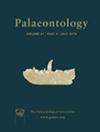悖论的迷失:奥陶纪腕足动物 Rafinesquina 的宽口解释了无附着滤食性蛙类如何在泥质基底上繁衍生息
IF 2.3
2区 地球科学
Q1 PALEONTOLOGY
引用次数: 0
摘要
栉孔腕足动物具有薄而凹凸不平的壳,是古生代泥质海床中无处不在的定殖动物,据推测,它们的滤食器呈凹陷向上的方向。这种取向会使它们的合生面脱离可能致命的嗜食性淤泥。矛盾的是,栉水母上的附生虫分布支持凸起向上的生活姿态,对栉水母稳定性的研究以及栉水母沉积物清理过程中形成的微量化石也支持这种生活姿态。凹面向上方位假说的前提是狭窄的口角,这会导致狭窄、高速的吸入流,使栉水母易受沉积物夹带的影响。在本文中,我们利用序列薄片和剥皮、硅化标本、计算机建模、扫描电子显微镜分析、X 射线显微 CT 和三维打印技术研究了栉水母的口角。铰链线结构表明,保守地说,霞糠穗草的开裂角度为 40-45°。当导管肌肉收缩不能导致进一步旋转时,铰链齿和齿嵴脱离,区域之间相互交错,就会出现这种张开。相反,当闭合时,铰链齿被锁定在铰链座中。这种宽阔的间隙消除了对进食方向的限制。无论是凸起向上还是凹陷向上的取食方向,栉水母都可以通过缓慢、弥漫的吸入气流取食,而这种气流无法扰动沉积物,同时栉水母还可以通过关闭瓣膜来强行排出足够的水,以清除地幔腔中的沉积物,这也解释了之前描述的与贝壳相关的壕沟状痕迹化石。我们的研究结果表明,当瓣膜关闭时,Rafinesquina 的缝隙角度约等于两个间区之间的角度。我们的分析表明,其他具有类似间隙角的栉水母类也是在贝壳张开的情况下生活的。本文章由计算机程序翻译,如有差异,请以英文原文为准。
Paradox lost: wide gape in the Ordovician brachiopod Rafinesquina explains how unattached filter‐feeding strophomenoids thrived on muddy substrates
Strophomenoid brachiopods had thin, concavo‐convex shells, were ubiquitous colonizers of Palaeozoic muddy seafloors, and are hypothesized to have filter‐fed in a concave‐upward orientation. This orientation would elevate their line of commissure out of potentially lethal lophophore‐clogging mud. The paradox is that epibiont distributions on strophomenoids support a convex‐upward life position, as do studies of strophomenoid stability and trace fossils formed by strophomenoid sediment‐clearing. A premise of the concave‐upward orientation hypothesis is a narrow gape, which causes narrow, high velocity inhalant currents, leaving strophomenoids vulnerable to sediment entrainment. Herein we investigate the gape angle of Rafinesquina using serial thin sections and peels, silicified specimens, computer modelling, SEM analysis, x‐ray microCT, and 3D printing. Hinge line structure suggests that, conservatively, Rafinesquina could gape 40–45°. Such a gape occurred when diductor muscle contraction could not cause any further rotation, hinge teeth and crenulations were disengaged, and interareas interlocked. In contrast, when closed, hinge teeth were locked in hinge sockets. This wide gape eliminates constraints on feeding orientation. In either convex‐up or concave‐up orientation, Rafinesquina could feed with slow, diffuse inhalant currents incapable of disturbing sediment, and could snap valves shut to forcefully expel enough water to clear sediment from the mantle cavity, explaining previously described moat‐shaped trace fossils associated with shells. Our findings demonstrate that Rafinesquina gaped at an angle approximately equal to the angle between the two interareas when the valves are closed. Our analyses hint that other strophomenoids with similar interarea angles also lived with their shells widely agape.
求助全文
通过发布文献求助,成功后即可免费获取论文全文。
去求助
来源期刊

Palaeontology
地学-古生物学
CiteScore
5.60
自引率
3.80%
发文量
43
审稿时长
6 months
期刊介绍:
Palaeontology publishes a wide variety of papers on palaeontological topics covering:
palaeozoology
palaeobotany
systematic studies
palaeoecology
micropalaeontology
palaeobiogeography
functional morphology
stratigraphy
taxonomy
taphonomy
palaeoenvironmental reconstruction
palaeoclimate analysis and biomineralization studies.
 求助内容:
求助内容: 应助结果提醒方式:
应助结果提醒方式:


